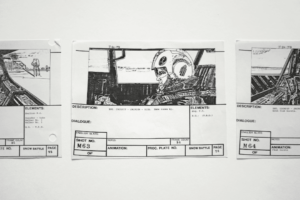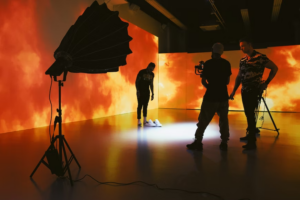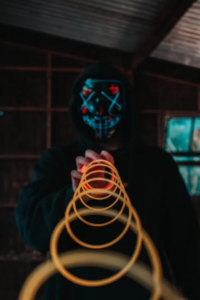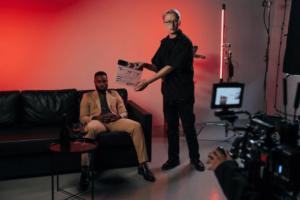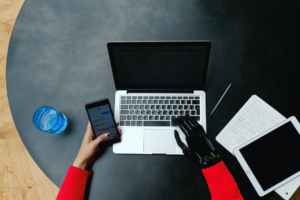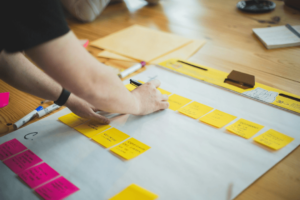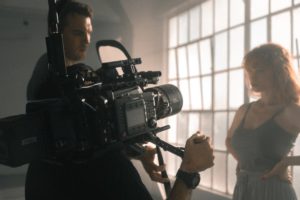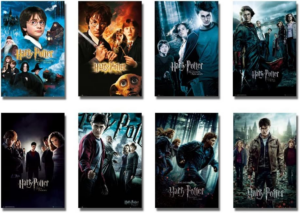Compositing is a digital image processing technique used in filmmaking, photography, and graphic design to combine multiple visual elements or layers into a cohesive image or video. It involves blending, adjusting, and manipulating various elements such as images, videos, 3D renderings, and special effects to create a final composition that appears seamless and realistic. Compositing enables artists and filmmakers to create stunning visual effects, merge actors into computer-generated environments, and enhance the overall visual appeal of their projects. It plays a major role in creating movies, advertisements, and digital art by facilitating the integration of diverse elements into a cohesive and visually captivating whole. Let’s discover the magic of compositing in visual media.

What is Compositing in Films?
Film compositing is a vital post-production method that merges multiple visual components or layers, such as live-action scenes, computer-generated imagery (CGI), and special effects, to produce a seamless and unified final image. This process allows filmmakers to bring fantastical worlds, creatures, and breathtaking environments to life, enhancing storytelling and visual impact. Compositing artists meticulously blend these elements using Adobe After Effects or Autodesk Flame, adjusting lighting, color, and transparency to make the composite appear realistic and integrated. Compositing is instrumental in achieving stunning visual effects, from epic battles in fantasy movies to mind-bending scenes in science fiction, ultimately elevating the cinematic experience for audiences worldwide.
History of Compositing
Compositing is a technique used in filmmaking, photography, and digital media to combine multiple visual elements into a single image or sequence. The history of compositing can be traced back to the early days of cinema and has evolved significantly over the years.
In the early 20th century, filmmakers experimented with compositing to create special effects in silent films. One of the earliest examples is Georges Méliès’ 1902 film “A Trip to the Moon,” which used multiple exposures and hand-painted frames to achieve otherworldly effects. This marked the beginning of compositing as a tool for storytelling and visual effects in film.
The development of color film in the 1930s and 1940s introduced new possibilities for compositing. Filmmakers could now combine color elements to create more realistic and visually stunning scenes. Techniques like matte painting and rear projection became popular for adding backgrounds and environments to on-set footage.
The 1970s and 1980s saw significant advancements in compositing technology with the introduction of computer-generated imagery (CGI). Films like “Star Wars” (1977) and “Tron” (1982) used early computer-generated effects to create otherworldly settings and characters. These developments laid the foundation for the digital compositing techniques we use today.
In the 1990s, software like Adobe After Effects and Discreet Combustion made digital compositing more accessible to filmmakers and artists. This era also saw the rise of digital compositing in television, advertising, and music videos. Directors and visual effects artists began compositing to achieve various creative and practical goals, from enhancing practical effects to creating entirely digital worlds.
The 21st century brought about a digital revolution in compositing. Software like Adobe Photoshop, Adobe After Effects, Nuke, and Autodesk Flame became industry standards for compositing and visual effects. High-definition and digital cinema cameras allowed for greater compositional flexibility, as digital files were easier to manipulate and combine.
Today, compositing has become an essential component of various fields, including filmmaking, advertising, video games, and other forms of visual media. It continues to evolve with technological advancements, including virtual reality, augmented reality, and real-time rendering engines. Compositing artists and software engineers continually push the boundaries of what is possible, creating increasingly realistic and immersive visual experiences for audiences worldwide.
Is Compositing a VFX?
Compositing is a fundamental visual effects (VFX) aspect in filmmaking and digital media. Compositing combines multiple visual elements, such as live-action footage, computer-generated imagery (CGI), matte paintings, and other assets, to create a final, cohesive image or sequence. In the context of VFX, compositing plays a crucial role in integrating various elements seamlessly to achieve the desired visual effects. It is used to:
Merge live-action footage with CGI elements
Compositing allows filmmakers to blend real actors and physical sets with computer-generated creatures, environments, or effects. This integration creates a realistic and cohesive visual experience.
Add and enhance special effects
Compositors can insert explosions, fire, smoke, weather effects, and other elements into a scene, making them appear like they are naturally part of the environment.
Create digital environments
Matte painting and digital set extensions involve compositing to extend or replace real-world backgrounds with digitally created landscapes, cityscapes, or fantasy realms.
Remove unwanted elements
Compositing can remove objects or elements from a scene that should not be present, such as wires holding up actors or crew members inadvertently captured in the frame.
Adjust and color-correct footage
Compositing can also be used for color correction, grading, and overall image enhancement, ensuring visual consistency throughout a project.
In summary, compositing is a core VFX technique that allows filmmakers to manipulate and combine various visual elements to create convincing and captivating effects in films, television shows, commercials, and other forms of visual media. It is critical to seamlessly integrate real and digital elements to enhance storytelling and visual impact.
What are the Techniques of Composting?
Compositing is a versatile and complex process involving combining multiple visual elements to create a cohesive image or sequence. Various techniques and methods are employed in compositing to achieve different visual effects and seamlessly integrate elements. Here are some of the key techniques used in compositing:
Layer-Based Compositing
This is the foundational technique in compositing, where different visual elements are stacked as layers in a software program (e.g., Adobe After Effects, Nuke, or Photoshop). Each layer can have its properties, including opacity, blending modes, and transformation parameters. Compositors manipulate these layers to achieve the desired result.
Keying
Keying removes a specific color or range of colors (usually a green or blue screen background) from the footage, leaving only the subject. This technique is commonly used for inserting actors into different backgrounds or adding visual effects behind them.
Rotoscoping
Rotoscoping involves manually tracing around objects or subjects in each frame of a video or film. It’s often used when keying isn’t ineffective or when fine details, such as hair or intricate motion, must be preserved.
Matte Painting
Matte painting is a technique where artists create highly detailed backgrounds or environments added to live-action footage. These painted images often extend sets, create fantasy worlds, or transport characters to different locations.
Matchmoving and Camera Tracking
Matchmoving involves tracking the camera’s movement and position during the live-action shoot. This data is then used to precisely position and animate 3D elements in the scene, ensuring they appear to interact with the live footage realistically.
Masking and Rotosplining
Masks isolate specific areas or objects in an image or video. Rotosplining is a process of creating detailed masks that follow the contours of objects within a frame. These masks can be used for various compositing tasks, such as color correction, effects application, or object removal.
3D Compositing
Besides 2D compositing, 3D compositing involves integrating three-dimensional computer-generated elements (e.g., characters, objects, or environments) into live-action footage. This requires 3D tracking and rendering capabilities.
Color Grading and Correction
Compositing software often includes tools for adjusting the footage’s color, contrast, and overall look to achieve a consistent and visually appealing result.
Blending Modes
Blending modes determine how different layers interact with each other. They control how pixels from one layer combine with pixels from other layers based on various mathematical operations, such as additive, subtractive, or screen blending.
Particle and Simulation Integration
Compositors can integrate particle effects, simulations (e.g., smoke, fire, or water), and dynamic simulations (e.g., cloth or hair) into live-action footage to create realistic and dynamic visual effects.
These methods can be used individually or in tandem to accomplish diverse visual effects and compositing assignments. These assignments encompass everything from simple color correction to developing intricate and creative environments in film, television, advertising, and digital media. The decision regarding which technique to employ is contingent upon the project’s distinct requirements and the desired artistic outcome.
What is Compositing in 3D Animation?
Compositing in 3D animation refers to integrating computer-generated 3D elements, such as characters, objects, environments, and effects, into live-action footage or other 3D scenes to create a seamless and cohesive final image or sequence. It is a crucial step in the production pipeline of visual effects (VFX), animated films, and various other forms of media where 3D and real-world elements need to coexist.
Here are the key aspects of compositing in 3D animation:
Integration of 3D Elements
Compositing allows 3D elements, such as characters or objects created in 3D modeling and animation software (e.g., Autodesk Maya, Blender, or Cinema 4D), to integrate into live-action footage or other 3D environments seamlessly. This involves matching the lighting, perspective, and color of the 3D elements to the live footage or background.
Camera Tracking
In many cases, compositing in 3D animation requires camera tracking. This process involves analyzing the movement and position changes of the live-action camera during shooting to recreate the same camera movement in the 3D software. This ensures that the 3D elements are properly aligned with the live footage, creating a convincing illusion of interaction.
Lighting and Shading
Compositors may need to adjust the lighting and shading of 3D elements to match the lighting conditions of the live-action scene. This includes adjusting the intensity, color, and direction of lights in the 3D environment.
Shadow Integration
To make 3D elements appear realistic within a live-action scene, compositors often need to cast accurate shadows for the 3D objects onto the live footage. This can involve shadow mapping or ray tracing techniques.
Reflections and Refractions
Depending on the scene, compositors may add reflections or refractions to 3D objects to make them interact realistically with their surroundings, especially when dealing with glass or water.
Depth of Field
Compositors can simulate depth of field effects, blurring parts of the image to match the camera’s focus, adding to the realism of the final composite.
Color Correction and Grading
Color correction and grading are often applied to the live-action and 3D elements to ensure a consistent look throughout the composite.
Integration of Effects
Special effects such as smoke, fire, explosions, and particle simulations can be generated using 3D software and then integrated into live-action footage through compositing.
Matte Creation
Compositors may use mattes to isolate specific areas of the live-action footage or 3D render for further adjustments or compositing. Mattes can be created through various techniques, such as rotoscoping or keying.
Final Rendering
Once all adjustments and compositing tasks are complete, the final image or sequence is rendered, producing the composite used in the final production.
In 3D animation, compositing requires a thorough grasp of 3D graphics and compositing techniques. Skilled compositors play a vital role in ensuring that the integration of 3D elements into live-action or other 3D scenes looks smooth and genuine, making a substantial contribution to the overall quality of the final visual product.
What is the Purpose of Compositing?
The purpose of compositing is to seamlessly combine multiple visual elements, such as live-action footage, computer-generated imagery (CGI), and special effects, into a unified and compelling image or sequence. It enhances realism, creates stunning visual effects, manipulates environments, and ensures visual consistency, ultimately contributing to the storytelling and overall visual impact of films, animations, photographs, and digital media projects. Compositing allows for creative expression and problem-solving, enabling artists and filmmakers to achieve their artistic vision and engage audiences with captivating visuals.
Why Use Compositing?
Compositing is used for several important reasons across various fields, such as filmmaking, photography, animation, and digital media:
Visual Integration
Compositing allows for the seamless integration of multiple visual elements into a cohesive composition. This includes combining live-action footage with CGI, special effects, or digital backgrounds, making it appear that all elements coexist naturally within the same scene.
Enhancing Realism
Compositing is a crucial tool for enhancing the realism of a scene. It enables adjustments to light, shadows, reflections, and other visual attributes to make elements look like they belong in the environment, thereby creating a more convincing and immersive experience for the audience.
Special Effects
Compositing is essential for adding and enhancing special effects, whether explosions, fire, smoke, or other dynamic elements. These effects can be created digitally and seamlessly into the live-action footage, adding excitement and spectacle to visual storytelling.
Environmental Manipulation
Compositing techniques like matte painting and digital set extensions allow for the creation of expansive or fantastical environments that may not exist in reality. This is particularly valuable for fantasy, science fiction, and historical films.
Object Removal and Cleanup
Compositing can remove unwanted elements or imperfections from footage, including wires, rigs, blemishes, or even entire objects or people. It helps achieve a polished and error-free final result.
Color Grading and Correction
Compositing tools are often used for color grading and correction to achieve a consistent and visually appealing look throughout a project. This can set the mood, enhance storytelling, and ensure a coherent visual style.
Creative Expression
Compositing allows creative manipulation of visual elements, enabling artists and filmmakers to experiment with unique and imaginative visuals. This can include surreal or abstract compositions that contribute to artistic expression.
Seamless Transitions
In filmmaking, compositing creates smooth transitions between scenes or shots, ensuring the narrative flows seamlessly without distracting jumps or cuts.
Visual Consistency
Compositing helps maintain visual consistency in projects where elements are shot at different times or locations. By adjusting lighting, color, and other visual attributes, compositors ensure that all elements harmonize within the same visual universe.
Efficiency
Compositing can often be a more efficient and cost-effective way to achieve certain visual effects or scene alterations than practical methods, such as building physical sets or using extensive practical effects.
In summary, compositing is a versatile and essential technique to enhance visual storytelling, create stunning visuals, correct imperfections, and achieve artistic and technical goals across various forms of visual media production. It enables filmmakers, photographers, and artists to bring their creative visions to life and engage audiences with compelling and immersive visuals.
What are Manual Compositing Techniques?
Manual compositing techniques combine and manipulate visual elements in a composition without specialized software or digital tools. These techniques are often performed by hand or using traditional art methods. While digital compositing has largely replaced manual methods in modern filmmaking and visual effects, manual compositing techniques are still relevant in certain artistic and historical contexts. Here are some examples of manual compositing techniques:
Multiple Exposure
In early filmmaking and photography, multiple exposures were used to create composites. This involved exposing the same piece of film or photographic plate multiple times, each time with a different subject or element in the frame. The resulting image would combine all the exposures into a single composition.
Glass Matte Painting
Before the digital era, matte painters would paint detailed backgrounds on sheets of glass or other transparent surfaces. These painted glass panels would then be placed in front of the camera and aligned with live-action footage, creating the illusion of expansive or exotic environments.
Silhouette Animation
Silhouette animation, also known as shadow animation, is a technique where cut-out shapes or figures are manipulated frame by frame against a backlit screen. This technique was used in early animation and can create striking and surreal visuals.
Stop-Motion Animation
In stop-motion animation, physical objects or models are incrementally moved and photographed frame by frame. These individual frames are combined to create the illusion of motion, sometimes involving manual compositing of practical effects elements into the animation.
Rotoscoping
Rotoscoping is a manual technique in which artists trace live-action footage frame by frame to create animated versions of the footage. It can be used for various artistic and visual effects purposes.
Scratch Film
In scratch film animation, artists manually scratch or etch directly onto a film strip to create abstract or surreal visual effects. The scratched areas allow light to pass through, creating unique and often otherworldly imagery.
Collage and Montage
In visual arts and filmmaking, collage, and montage involve manually cutting, arranging, and gluing together images or film strips to create composite visuals. These techniques are often used for artistic and narrative purposes.
Hand-Painted Effects
Artists may manually paint or draw special effects elements frame by frame, such as explosions, lightning, or magical effects. These hand-painted elements can be composited onto live-action footage to enhance scenes.
While digital compositing has largely replaced manual techniques in mainstream filmmaking and VFX due to its efficiency and flexibility, manual compositing methods are still appreciated in art, experimental filmmaking, and historical contexts. They offer a hands-on and tactile approach to creating visual compositions, and in some cases, they produce unique and visually captivating results.
Best Tools for Compositing
Compositing is typically performed using specialized software tools and applications, which offer a wide range of features and capabilities for combining, manipulating, and enhancing visual elements. Here are some of the most commonly used compositing tools and software:
Adobe After Effects
Adobe After Effects stands out as one of the most widely used compositing and motion graphics software in the film, television, and digital media industries. It provides various tools for compositing, animation, color correction, and visual effects.
The Foundry Nuke
Nuke is a high-end compositing and visual effects software extensively utilized in the film and television sector. Its node-based compositing workflow offers robust flexibility for complex compositing tasks.
Blackmagic Fusion
Fusion is a node-based compositing software that offers both 2D and 3D compositing capabilities. It’s used for various visual effects and compositing work, including feature films and broadcast graphics.
Autodesk Flame
Flame is a high-end compositing and finishing software used for compositing, color grading, and visual effects in the post-production industry. It’s known for its robust feature set and integration with other Autodesk products.
Adobe Photoshop
While primarily an image editing tool, Photoshop can also be used for basic compositing tasks, such as combining multiple images, adjusting layers, and applying masks.
Apple Motion
Motion is Apple’s motion graphics and compositing software, often used with Final Cut Pro for video editing and compositing.
HitFilm Express
HitFilm Express is a free video editing and compositing software with extensive visual effects and compositing capabilities. It is suitable for both beginners and independent filmmakers.
Blender
Blender is a free, open-source 3D modeling, animation, and compositing software. It includes a node-based compositor for compositing 3D and 2D elements.
Fusion Studio
Fusion Studio is a more advanced version of Blackmagic Fusion, offering additional features and capabilities for professional compositing and visual effects work.
Mocha Pro
Mocha Pro is known for its advanced planar tracking and rotoscoping capabilities, making it a valuable tool for compositing tracking and masking tasks.
Natron
Natron is a no-cost, open-source compositing software that utilizes a node-based approach and provides features similar to those found in paid commercial compositing tools.
SilhouetteFX
Silhouette is a specialized software for advanced rotoscoping, painting, and compositing tasks, often used for high-quality visual effects work.
The choice of compositing tool depends on various factors, including the project’s complexity, the user’s familiarity with the software, and the specific requirements of the compositing task. Professionals in the VFX and post-production industry often use a combination of these tools to achieve their desired results.
Compositing Examples in Movies
Compositing is a fundamental technique used in filmmaking to combine multiple visual elements and create seamless, convincing visual effects. Here are some movie examples that showcase the use of compositing for various effects:
Jurassic Park (1993)

Directed by Steven Spielberg, “Jurassic Park” is known for its groundbreaking use of compositing to bring dinosaurs to life. The film seamlessly blends CGI dinosaurs with live-action actors and environments, creating a realistic and thrilling experience for audiences.
Jurassic Park 3d Extended Trailer
[Jwatchnow link=”https://www.amazon.com/Jurassic-Park-Sam-Neill/dp/B009CGKW10/ref=sr_1_2?crid=17FRO4605BESI&keywords=jurassic+park&qid=1697400235&sprefix=jurrasic+park%2Caps%2C447&sr=8-2″ watchon=”Amazon”]
Forrest Gump (1994)
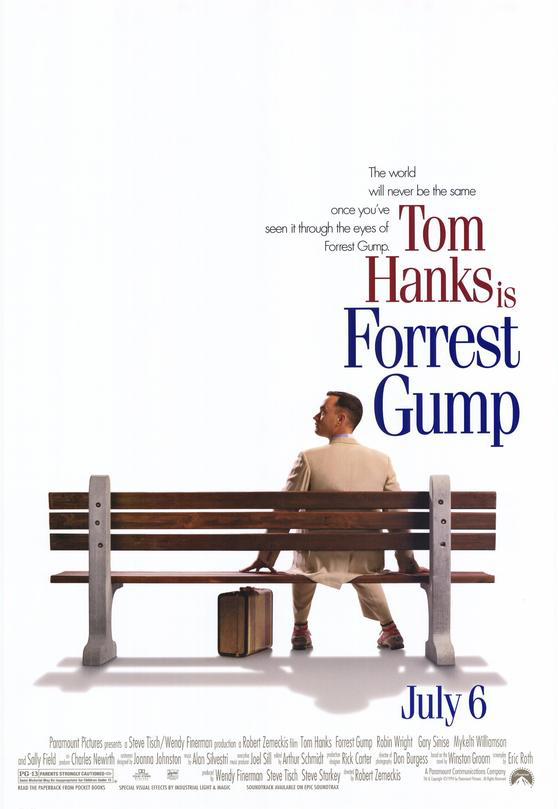
Directed by Robert Zemeckis, “Forrest Gump” features compositing techniques that place the main character, Tom Hanks, into historical footage and events, making it appear that he is interacting with real historical figures.
Forrest Gump (1994) Trailer #1 | Movieclips Classic Trailers
[Jwatchnow link=”https://www.amazon.com/Forrest-Gump-Tom-Hanks/dp/B002QVZ71I/ref=sr_1_3?crid=BN03PB9DCIQI&keywords=forrest+gump&qid=1697400269&sprefix=forrest+%2Caps%2C834&sr=8-3″ watchon=”Amazon”]
The Matrix (1999)
Directed by the Wachowskis, “The Matrix” uses compositing to create iconic visual effects, including “bullet time” sequences and manipulating reality within the Matrix. These effects involve the combination of live-action, CGI, and practical elements.
The Matrix (1999) Official Trailer #1 – Sci-Fi Action Movie
[Jwatchnow link=”https://www.amazon.com/Matrix-Keanu-Reeves/dp/B000GJPL1S/ref=sr_1_1?crid=QMOPIUHOAMHH&keywords=matrix&qid=1697400339&sprefix=matri%2Caps%2C482&sr=8-1″ watchon=”Amazon”]
The Lord of the Rings- Trilogy (2001-2003)

This epic fantasy trilogy, directed by Peter Jackson, utilizes extensive compositing to bring Middle-earth to life. It involves the integration of live-action actors, practical effects, miniatures, and CGI creatures into seamless, breathtaking landscapes.
The Lord of the Rings: The Rings of Power – Official Trailer | Prime Video
[Jwatchnow link=”https://www.amazon.com/Official-Trailer/dp/B09QHB3RTX/ref=sr_1_2?crid=3QIPJQ8Y7BG5A&keywords=lord+of+the+rings&qid=1697400365&sprefix=lord+of+the+rings%2Caps%2C374&sr=8-2″ watchon=”Amazon”]
Avatar (2009)

Directed by James Cameron, “Avatar” is known for its groundbreaking use of CGI and compositing to create the alien world of Pandora. The film combines live-action footage with photorealistic CGI characters and environments.
Avatar | Official Trailer (HD) | 20th Century FOX
[Jwatchnow link=”https://www.amazon.com/Avatar-Sam-Worthington/dp/B0B6583PVV/ref=sr_1_2?crid=AFON9RKFF88R&keywords=avatar&qid=1697400487&sprefix=avat%2Caps%2C1099&sr=8-2″ watchon=”Amazon”]
Inception (2010)

Directed by Christopher Nolan, “Inception” features visually stunning compositing work to create mind-bending dreamscapes and gravity-defying scenes. It blends practical effects with CGI to create a visually immersive experience.
Inception (2010) Official Trailer #1 – Christopher Nolan Movie HD
[Jwatchnow link=”https://www.amazon.com/Inception-Leonardo-DiCaprio/dp/B0047WJ11G/ref=sr_1_1?crid=J3S2CR18A498&keywords=inception&qid=1697400533&sprefix=inception%2Caps%2C421&sr=8-1″ watchon=”Amazon”]
Gravity (2013)

Directed by Alfonso Cuarón, “Gravity” relies heavily on compositing to create the illusion of zero-gravity space. The film seamlessly integrates live-action actors, their performances, and computer-generated backgrounds to achieve a visually immersive space environment.
Gravity – Official Main Trailer [2K HD]
[Jwatchnow link=”https://www.amazon.com/Gravity-Sandra-Bullock/dp/B00HJ957BC/ref=sr_1_3?crid=3A8HWCD8SG73F&keywords=gravity&qid=1697400629&sprefix=gravity%2Caps%2C410&sr=8-3″ watchon=”Amazon”]
Guardians of the Galaxy (2014)
This Marvel film, directed by James Gunn, showcases compositing to bring together live-action actors, animatronics, and CGI characters, including Rocket Raccoon and Groot.
Marvel’s Guardians of the Galaxy – Trailer 1 (OFFICIAL)
[Jwatchnow link=”https://www.amazon.com/Guardians-Galaxy-Theatrical-Chris-Pratt/dp/B00QROJ94Q/ref=sr_1_4?crid=1AWD4KSO4Q3RO&keywords=guardians&qid=1697400663&sprefix=gard%2Caps%2C484&sr=8-4″ watchon=”Amazon”]
Mad Max: Fury Road (2015)

This action-packed film, directed by George Miller, uses compositing for various practical and digital effects, including blending live-action stunts and CGI-enhanced sequences.
Mad Max: Fury Road – Official Main Trailer [HD]
[Jwatchnow link=”https://www.amazon.com/Mad-Max-Fury-Tom-Hardy/dp/B00XOXDXV8/ref=sr_1_3?crid=11YAHIT2DWFFM&keywords=mad+max&qid=1697400862&sprefix=mad+ma%2Caps%2C444&sr=8-3″ watchon=”Amazon”]
The Jungle Book (2016)

This adaptation of Rudyard Kipling’s book, directed by Jon Favreau, uses compositing to create a photorealistic jungle environment and digitally animate the animals. The film combines live-action performances with CGI to achieve a convincing world.
The Jungle Book Official Big Game Trailer
[Jwatchnow link=”https://www.amazon.com/Jungle-Book-Theatrical-Bill-Murray/dp/B01E60YZNM/ref=sr_1_1?crid=3AE2I90CSXHPN&keywords=The+Jungle+Book%22+%282016%29%3A&qid=1697400892&sprefix=the+jungle+book+2016+%2Caps%2C717&sr=8-1″ watchon=”Amazon”]
These movies demonstrate the versatility of compositing in creating a wide range of visual effects, from bringing fantastical creatures and worlds to life to seamlessly integrating characters into historical events and manipulating reality within a narrative. Compositing plays a key role in modern filmmaking, enabling filmmakers to expand the possibilities of storytelling and create immersive visual experiences.
Videos
Top 5 Tips: Improve your VFX compositing
VFX Games – The Art of Compositing
Avengers: Endgame VFX | Breakdown – Compositing | Weta Digital
VFX compositing showreel 2022 by Visual Knights
Best Compositing Programs For VFX
How Movie VFX Are Made: The 8 Steps of Visual Effects!


